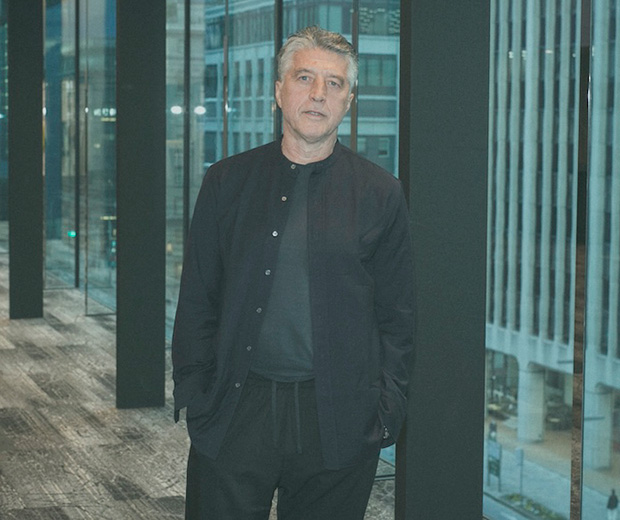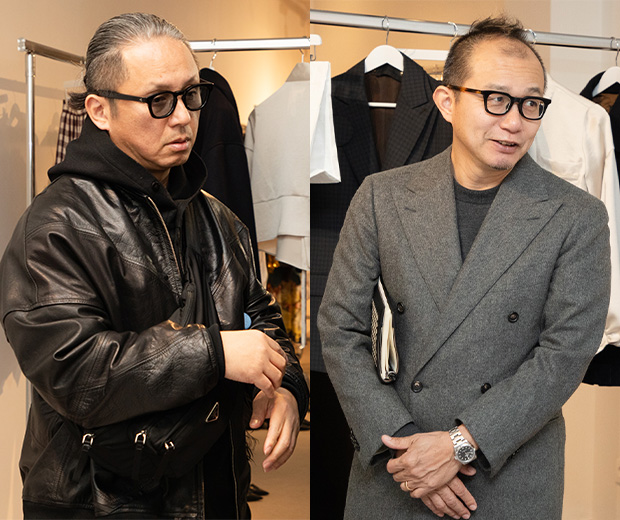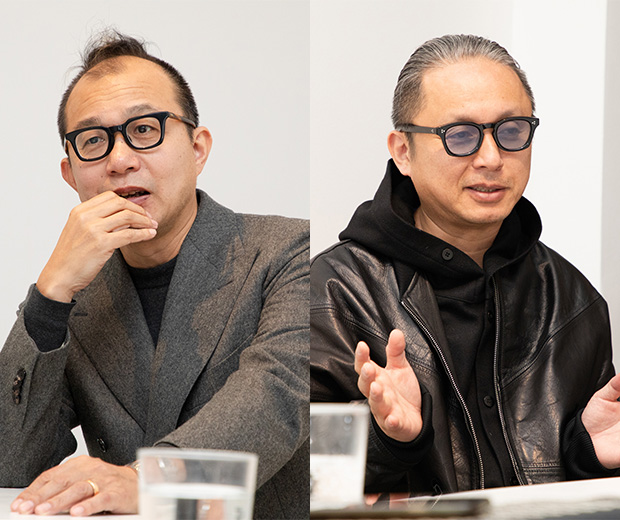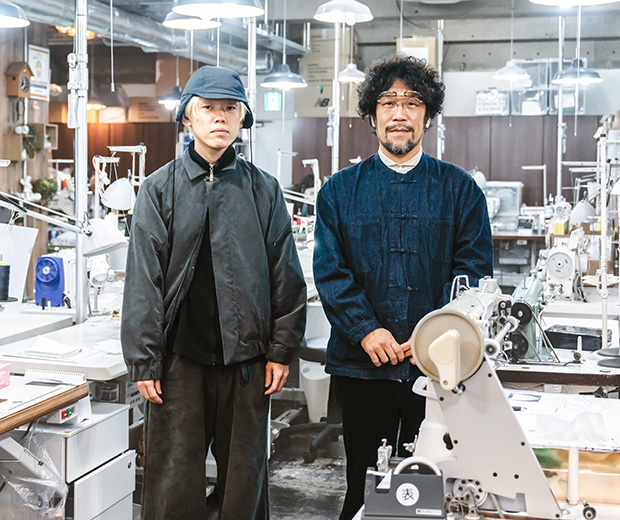Takeshi Kitazawa / Emiko Sato
DRESSEDUNDRESSED is an up-and-coming brand, known for its all-monochrome and minimalistic designs under the theme of combining two contradicting elements, e.g. men and women, classic and punk, since its launch in 2009. Its reputation has already spread overseas, as seen in its participation in the Singapore Fashion Week last year. The brand also represented Japan in the International Woolmark Prize (hereinafter “IWP”), held in London recently, upon special recommendation by the Vogue Italia editor-in-chief Franca Sozzani. We interviewed the brand’s designer duo, Takeshi Kitazawa and Emiko Sato, who are in the middle of preparing for the up-coming launch of the 2013-14 A/W Collection.
What inspired you to launch the brand?
Kitazawa: When I was 24, the owner of a secondhand clothing store asked me, out of the blue, to help him open a new store called CANDY in Shinjuku 2-Chome. I had never studied fashion nor had expert knowledge in this area, but I accepted the offer, thinking that this would be a major opportunity and turning point in my life. I sounded the idea to Emiko and our British friend Rachel, and we 3 amateurs launched CANDY together.
Sato: In the course of working at the shop and being exposed to the world of fashion, we gradually developed and nurtured the desire to design clothes ourselves.
Kitazawa: At CANDY, we also remade clothes and sold them. The fact that we were able to see shoppers’ response to our creations first hand proved to be a valuable experience. After deciding to set up my own brand, I traveled to London, where I stayed at the house of a fashion designer. Visiting the ateliers of various creators there provided me with much-needed inspiration and courage to move forward. It was an interesting experience, making me have a re-think about my own Japanese mentality.
Why did you think of starting the brand together?
Sato: Music has always been a major influence for Takeshi and me. We share so much in common, for instance, what we like and what paths we have followed. I played classical music until junior high school, and when I entered high school, I was exposed to punk rock for the first time. I was shocked by its approach, which was completely opposite to classical music’s faithfulness to basic theories and what was written in sheet music. That mentality fascinated me greatly. Both of us started from there and became drawn to the world of fashion.
Kitazawa: We love both classical music and punk rock. Our approach is to try and find unique beauty where such contradicting elements meet.
That leads to the brand concept of “Binary Union”.
Kitazawa: That’s right. Gender is another important element here. For example, fashion for men relates largely to social position and occupation. People my age can be an office worker, lawyer or firefighter, for example, and they adopt different fashion styles according to what they are in society. We are exploring to what extent we can push people into embracing different fashion.
Sato: At the same time, the type of minimalistic clothes we create tends to be seen as something for men from a woman’s perspective. Being a woman, I have always loved the uncomplicated designs in men’s fashion, and used to wonder why there were no men’s clothes in women’s sizes. We are working on reflecting the image of strong and independent women to women’s clothes.
Kitazawa: We make patterns separately for men and women, especially in tailored suits, to create shapes that fit the body of each gender, and apply identical designs or use identical materials to achieve binary union.
You participated in IWP in London the other day. How was the people’s reaction to your brand over there?
Sato: Over there, people seem to think our clothes are “very Japanese”, which was surprising because, in Japan, our designs are often considered to be non-Japanese. It seems they consider our minimalistic designs with attention to detail to be “typically Japanese”.
Kitazawa: Japan’s long-standing appreciation of understated beauty and design approach with attention to detail are the elements that underscore our brand. It was great to see people in other parts of the world understand and appreciate that. Another reward we gained was the renewed recognition, through working with manufacturers of various materials, about the advanced level of Japan’s manufacturing approach and technologies. Having been chosen to represent Japan, and in order to meet the expectation of people who trusted and helped us, we were determined to produce quality items, recognizing the responsibility that the brand was given. For the show in Tokyo, we are hoping to showcase refreshed versions of pieces we presented in IWP.
What is your brand’s vision for the 2013-14 A/W Collection which will hit the runway next week?
Kitazawa: This collection is built around the 1983 movie “The Hunger”, starring David Bowie and Catherine Deneuve. Although it is a story about vampires, it is an elegant and modern movie, rather than a horror movie. Our collection is inspired by the leading role’s character placed between humans and vampires who have an eternal life. Overall, the collection combines classic and post-punk elements, and incorporate them into the modern world.
How do you decide on the theme of each season’s collection?
Kitazawa: We often draw inspiration from movies, artworks and architectures. Firstly, we examine the personality of a lead character. We define the image of people who would wear the clothes from the collection, before deciding on specific concepts and materials to be used. The image changes for each collection, but “binary” nature still remains as the keyword, e.g. the image in between men and women.
In other words, you are drawing design inspiration from the inner nature of human beings.
Kitazawa: I have not really been too conscious about it, but you might be right. I think you are what you wear. Our dedication to the color black reflects our desire to explore the color of our hair and eyes, or even the spirituality of Japanese people.
Sato: I have always loved black for its elegance and charm. Black comes in different shades and tones. Black materials that look the same at a glance could present totally different expressions because of a subtle difference in tone.
Kitazawa: Black hides no flaws, commanding you to get all the details and materials right. That is why it is perfect for our clothes, designed with absolute attention to detail. Choosing black gives us a good reason to pursue all the details including the texture and thickness of all the fabrics. In the process, we are striving to present the depth of this color.
You were playing a brand image video at the show. Is there anything you consciously do in terms of presentation?
Sato: Being a relatively new brand, we are conscious about to what extent we could convey the brand’s image to people who don’t know us. For this reason, video and music are very important. Old friends of ours handle the music for our shows. For every collection, we communicate and discuss all the fine details before they make the music.
Kitazawa: We hope to communicate the image we have about each collection in the forms of video and music, and show to the audience how the image has been turned into real clothes. We have drawn inspiration from music, movies and various other things. That is our strength. It would be great if these elements serve as inspiration for other people to become interested in our brand.
Video played at the runway show for the 2013 S/S Collection
Tell us about your future outlook.
Kitazawa: We are building solid foundations in Japan to evolve into a brand that can deliver solid collections overseas as well. It is fun to be able to communicate with people from around the world through fashion. I would love to work with all kinds of people overseas.
Sato: We have various other dreams, and are always talking about what we might want to do some day. We are a brand that gradually evolved from the first collection of just five styles of T-shirts four years ago. That is why we think it is crucial to nurture the brand steadily first.
Kitazawa: We showcased our collection in the Fashion Week a year ago, and someone in the audience gave us an offer to present the collection in Singapore and London. At the moment, we are working hard to present the show on the 18th in the best possible light.

2013 S/S Collection

The first runway show in the 2012-13 A/W Collection (At Mercedes-Benz Fashion Week TOKYO 2012-13 A/W)
2009: Established DRESSEDUNDRESSED.
2011: Exhibited at TRANOI SHOWROOM in Paris under the TOKYO EYE project.
2012: March: Presented 2012 A/W Collection at own runway show at Mercedes-Benz Fashion Week TOKYO. May: Selected as a Show Case Designer at Singapore Fashion Week "Blue Print" which features noteworthy designers worldwide. Participated in the opening show and exhibition.
October: Nominated by VOGUE Italia chief editor Franca Sozzani as the Japan national finalist as special entry for the International Woolmark Prize.
October: Presents 2013 S/S Collection at own runway show at the bellesalle SHIBUYA GARDEN.
November: Selected as JFW-JC PIGSKIN SHOW designer, presenting at the PIGSKIN SHOW.
2013: February: Presented Capsule collection at the International Woolmark Prize during the London Fashion Week.





